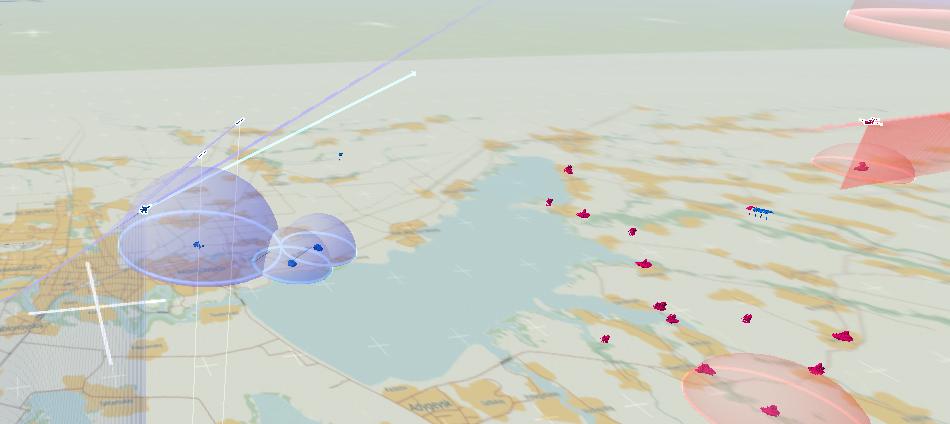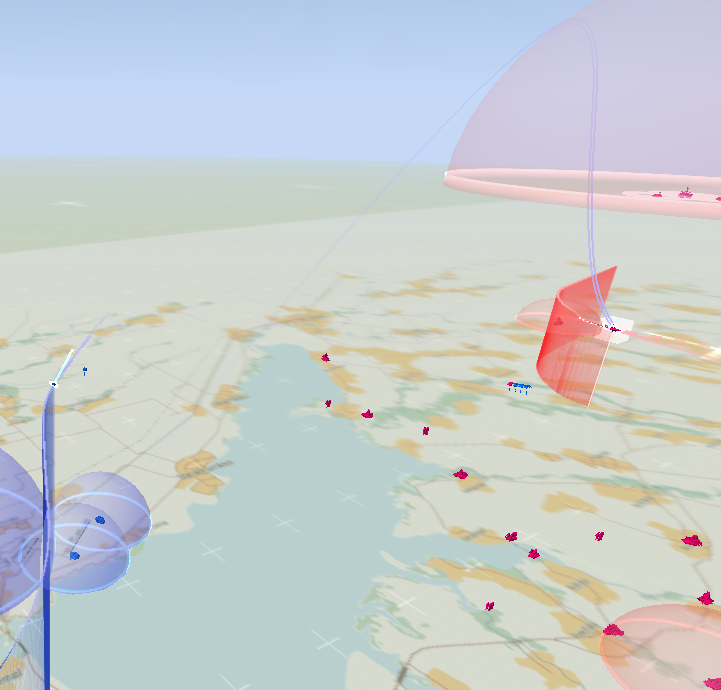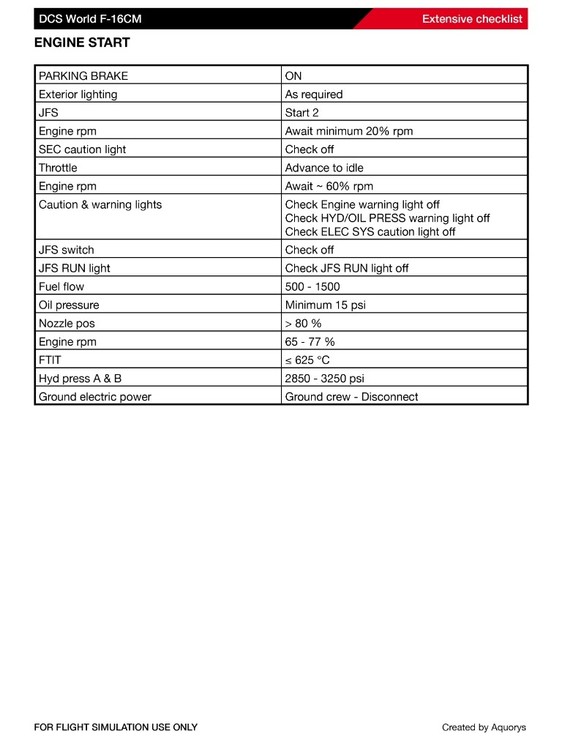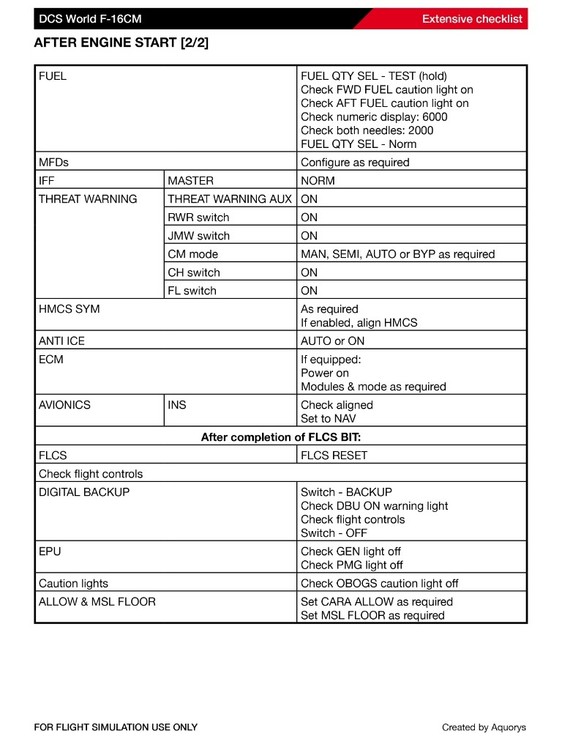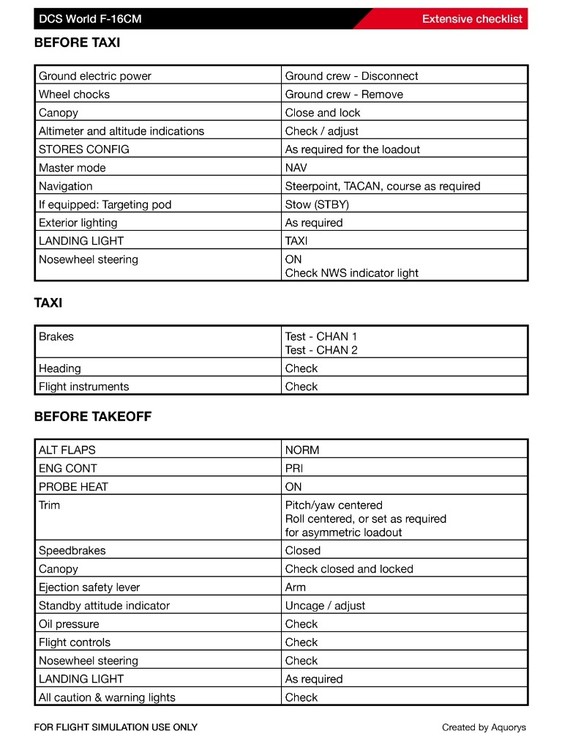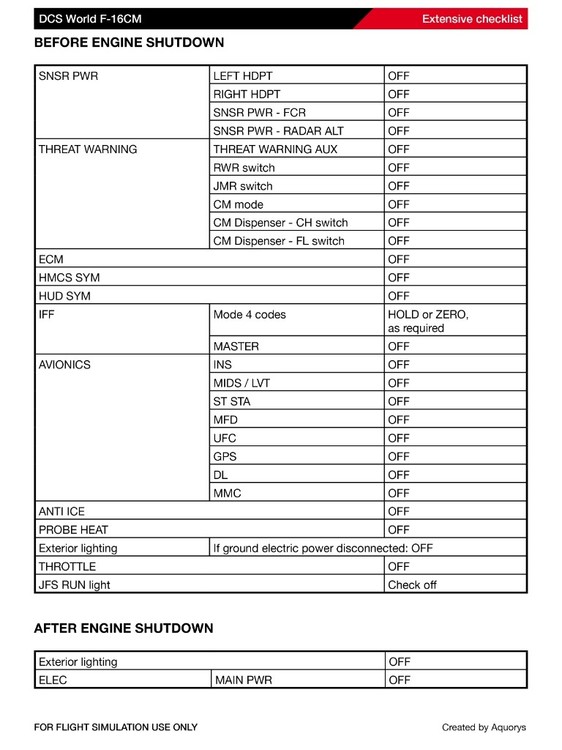-
Posts
327 -
Joined
-
Last visited
Content Type
Profiles
Forums
Events
Everything posted by Aquorys
-
Also, check the fuel flow display. That should normally show about 4000-9000. And don't fly around at tree level doing 500 knots, that will obviously consume a lot of fuel. If you want to go for a long time or go a long distance, fly high - I'd say, 28k - 35k ft sounds about right.
-
In a nutshell: 30x20 is approximately your HUD FOV, so it should pick up targets roughly in front of your aircraft 10x60 scans upwards, which makes sense when your lift vector is pointed towards the target 60x20 is slewable, so if the target isn't in front of you, but you know (or you think you know) a general direction, it can be helpful Boresight is a 3 degrees beam width search, and can be directed by the HMCS, so it's useful when you can see the target
-
If you're flying towards a waypoint anyway, you might as well just go to steerpoint select instead of attitude hold on the roll switch, that should kinda solve your problem.
-

correct as-is FCR Detection v Lock Range - Wait for Radar White Paper
Aquorys replied to skywalker22's topic in Bugs and Problems
It's a multi-mode radar, it uses both medium PRF and high PRF (high power/low duty cycle/medium PRF or low power/high duty cycle/high PRF), you just don't see it because the switching is done automatically by the system. -
It's used on the Typhoon, so apparently it isn't as terrible there, or maybe that might just explain why Typhoon folks tend to think that the AN/APG-68 isn't a great radar
-

correct as-is FCR Detection v Lock Range - Wait for Radar White Paper
Aquorys replied to skywalker22's topic in Bugs and Problems
The AN/APG-73 in the Hornet is partly related to the radars of the F-14 and F-15, so it isn't much of a surprise that it is more capable than the AN/APG-68 used in the F-16. It has been implied by several experts of the respective airframes that the F-16 and F/A-18 radars are underperforming in look-down situations (in DCS), and that is about as much as you'll hear from anyone, because the details concerning radar technology are one of the most closely guarded secrets in fighter aircraft. It sure is nice of ED that they're going to show us why they modeled the radar as they did, but then again, it's still going to be a white paper about their own fantasy world, it's still not going to tell you any hard facts about the real world AN/APG-68 or AN/APG-73 performance. In RWS, you can use spotlight search (hold TMS up) - although I'm not sure it really does much in DCS, it hasn't been effective when I tried to use it. You can narrow the scan azimuth and vertical scan angle using the settings on the left side of your FCR display ("A6", "4B"). If you are using TWS, always narrow the azimuth, or it will drop your system tracks every few seconds (just doesn't work well with the +/- 60 degrees scan angle). Once you have bugged a target, it will go into A2 anyway. Additionally, you can narrow the vertical scan angle by reducing the number of scan bars (that's the 4B .. 2B .. setting on your FCR display). I'm not sure how close to the real world the radar simulation in DCS is, but in general, a radar in RWS mode should have a higher chance of detecting new targets than one that's in TWS mode. Therefore, you could e.g. spotlight search in RWS near a datalink target until you get a contact, then go into SAM, or if you want to see more about what the other targets are doing, go into TWS from there (although with the datalink targets provided by an AWACS, that seems redundant). -
The ASC should indicate the ideal course for an AMRAAM launch if the target is in range, otherwise it should indicate an intercept course to the target. I made a thread about that in October 2021. It does. I've been guesstimating course and loft angles from the start, it results in higher missile speed and thereby also greater range. These are screenshots from a TacView of AMRAAM launches at a distance of 40 nm, at an AWACS that is patroling at 19k ft. Both missiles were still going at a speed somewhat above Mach 2 when they hit. And they weren't even fired at crazy high speed and altitude, this is from ~38k ft at M1.15. Good positioning and flight path before engaging targets are big factors.
-
Update: The checklists I created for the F-16 are now available in this thread. They are suitable for being added to the kneeboard.
-
Here are some checklists that you can put into your kneeboard. These files go into your home directory, subdirectory "Saved Games\DCS\Kneeboard\F-16C_50\". They are named so that they should come up in the correct order in your kneeboard (DCS apparently shows all the kneeboard files in alphanumeric order, keep that in mind if you want to rename the files). The checklists are as authentic as makes sense for the simulation, but obviously heavily adapted and shortened, as there are many items that just don't translate 1:1 from the real world to the simulation. This is the "Extensive checklist" variant, if I get bored enough and have the time, I'll probably follow up with a "Basic checklist" and an "Essential checklist" for those people who don't care for the level of detail and are just looking for something to get them started easily. Cheers, Aquorys
-
That's what "Sweep" is for. In a "CAP" role, you would typically want to patrol an area, and certainly not have a single fighter aircraft go on an Kamikaze mission by flying 200 miles into enemy territory in order to attack an AWACS that's defended by 2 escort fighters and is flying in a region defended by a highly capable air defense system. That just doesn't make any sense. I guess, what's really needed are some more settings on how the AI should behave - not just their task, like Sweep or CAP, but also their aggressiveness. Such a setting could control whether retreating aircraft are chased, or how much of a tactical advantage is required for the AI to press on. I guess I'll make a thread in the wishlist section for that, I have a rough idea how that could work. Also, the ROEs should be renamed. E.g. "weapons hold" doesn't mean you can't fire to defend yourself, but that is what it currently does in DCS. Watched it, but it didn't make too much sense. It looked more like a showcase of failed AMRAAM guidance than one on BVR tactics.
-
FWIW, I made my own checklists for the F-16 a while ago, they are customized for the in-game aircraft. I put them in the kneeboard, and I use them all the time. I'm planning to make them available in the forum, but I'd like to revise them once more first. The only problem I can possibly see with default checklists for each module would be what items to put on them. Somewhat comprehensive checklists are quite long (even though they are already shortened compared to the real jet, because some sections and items don't make too much sense in DCS), so new players who would just like to get the aircraft airborne quickly for some basic flight training would possibly be overwhelmed. With regards to memorizing checklists, there are some items on checklists that pilots must memorize, but they are not typically for normal procedures, they are the ones for emergency procedures that need to be executed so quickly that going through the checklist would not be practical. Those are called memory items, and they are clearly marked as such on the checklist. Apart from that, checklists are supposed to be used, not memorized. On some civilian aircraft, like e.g. the Airbus A320, the avionics computers will even run you through various checklists, and you either have to check the items or perform whatever task is required (the computer recognizes that and checks the item automatically), just to make sure you don't miss anything.
-
Better situational awareness if there is no AWACS to provide a picture
-
I made some Caucasus BVR training missions for the F-16 and posted them here in the F-16 Missions & Campaign forum, including a description of the missions. Six levels of difficulty, starting with unarmed passive drone-like targets close to the base, you having unlimited ammo & fuel, and progressing to a difficult final mission to take out an air superiority fighter. AWACS support & an air defense system at your base in case you need to run home. Plus some eye-candy aircraft on the ground at your home base, so you don't feel so lonely. I hope you folks like it, let me know what you think if you try them out.
-
In this thread, member swaps asked whether anyone had created a Caucasus theater BVR training mission. It was quite a lot of work, but I finally made a collection of training missions. Mission descriptions: All missions feature airborne aircraft in the target area, ready to jump in and engage targets, as well as aircraft that are ready to roll on the runway at the Kobuleti airfield. Levels 1 - 4 also feature cold & dark aircraft at the ramp for startup training. Your airfield is protected by an air defense system, so that you can land or take off again safely in case you need to run from a hostile aircraft. You are supported by an AWACS aircraft escorted by two fighters. There is also a little bit of eye-candy at the Kobuleti airfield, so you don't feel so alone at the ramp. The missions are arranged in ascending difficulty. This includes increasingly capable hostile aircraft, but also more realism (e.g., limited map view) and more difficult conditions in general. Level 1 - Sandbox 8 attack aircraft target drones, unarmed, and they do not react to threats in any way. Excellent visibilty, few clouds, no wind. This mission is ideal for learning the fundamentals, like how to use the radar and weapon systems. You have unlimited weapons and unlimited fuel in this mission. Level 2 - Strategic bomber targets Two bombers flying at high altitude over the black sea, armed with guns, but you probably shouldn't get that close. You have unlimited weapons in this mission, but you don't have unlimited fuel. Level 3 - Basic Hostile fighters patroling continuously near Sochi, armed with short-range missiles. This is an entry level mission for learning how to engage fighter targets and some basic combat tactics and maneuvering. Level 4 - Moderate A single hostile fighter patroling continuously near Sochi, armed with radar guided BVR missiles and short range missiles. Limited range air defenses at Sochi. This is where tactical BVR training begins, as your opponent is also BVR capable now. Level 5 - Challenging A single hostile air superiority fighter near Sochi, armed with radar guided BVR missiles and short range missiles. Low to high altitude air defenses at Sochi. Situational awareness, exploiting tactical advantages and missile evasion skills are the key to mastering this mission. Level 6 - Intense A single hostile air superiority fighter near Sochi, armed with various BVR missiles and short range missiles. Powerful low to high altitude air defenses at Sochi. If you haven't had enough so far, this final mission requires some serious flying and tactical skills if you want to make it home in one piece. Note that shooting down the hostile aircraft should not be your only priority as you progress in your training. The missions are designed so that you should be able to fly back home and land as an optional challenge to complete each mission. This also means that you may sometimes have to abort the mission. Please let me know if something seems wrong or dysfunctional to you. Cheers & y'all have fun! Caucasus BVR Training - Level 1 - Sandbox.miz Caucasus BVR Training - Level 2 - Strategic bomber targets.miz Caucasus BVR Training - Level 3 - Basic.miz Caucasus BVR Training - Level 4 - Moderate.miz Caucasus BVR Training - Level 5 - Challenging.miz Caucasus BVR Training - Level 6 - Intense.miz
- 1 reply
-
- 10
-

-

-
If you have a VR mirror application that mirrors what you see in the VR headset to the screen (typically cropped to screen dimensions), you can select the window of that application in OBS as the source window. That is what worked best for me so far. The nVidia graphics cards come with an option that allows you to record the graphics output to the screen too, but I have not yet figured out if it can also directly record the VR graphics output. If anyone knows how to do that, that would be great to know too.
-
I had a similar problem, see this thread in the New User Briefing Room section. Long story short, with AI set to an ROE of "Weapons free", they did not follow waypoints and flew for hundreds of miles to engage random targets, and with any other ROE they did not defend themselves at all, unless I went into dogfights with them. Might be worth a new thread on the DCS wishlist, there are some things wrong with the ROEs anyway, and I also think AI could use a more generic behavior setting that tells them how aggressive the AI pilots should act. Currently, if they decide to engage, they basically go full Kamikaze mode on a single target with no respect for self-preservation at all.
-

Why radar cursor switch has so big dead zone on MAV page?
Aquorys replied to Marklar's topic in Controller Questions and Bugs
Yeah, same problem with Mavericks for me Edit: Also the Warthog throttle, by the way -
What aircraft are you going to fly in this BVR training mission? I tried to create a training mission with various targets, but it is almost impossible to get those AI aircraft that are supposed to be somewhat more difficult targets to do anything useful. If I configure them for CAP and set their ROE to "weapons free", they decide on their own that waypoints or an area to defend aren't a thing, and go on a suicide mission half across the map to attack random aircraft in the middle of an air defense zone. If I set the ROE to anything else, they fly along their waypoints, but don't defend themselves at all, unless you go into dogfights with them. There does not seem to be any possibility to configure the AI to fly defensive counter air missions, where they would perform point-defense and also defend themselves if threatened. Some of the other roles that I've tried, like AFAC, or just "Nothing", didn't lead to any useful results either.
-
If an online/multiplayer mission is an option for you, there are some PvE (humans vs. AI) servers out there that have suitable targets. E.g., OFS (open flight school) has trigger areas that spawn easy, medium, hard fighter targets and heavy bomber targets. There are also air-to-ground training targets available. 504VFS also has an air-to-air area that also contains some hot ground targets, along with an area of inert ground targets and area of hot air defense systems 162nd Vipers has various intermixed air-to-air and air-to-ground targets. 4YA has missions where you conquer air bases, and the scenario is an intermixed air-to-air/air-to-ground mission with integrated multi-layered air defense systems.
-
If this is supposed to be a real life question rather than an in-game question, there is no single answer to this question, because the behavior depends on the situation (e.g., one vs. multiple aircraft) and the capabilities of the platform (aircraft) being used.
-

correct as-is Viper energy retention, or lack of it.
Aquorys replied to b0bl00i's topic in DCS: F-16C Viper
Sounds no different than it was, if you're slow, maneuvering and diving, it might still not pick up speed. That wasn't any different before. The rest sounds more like a Hornet problem than a Viper problem. The Hornet isn't a 9G aircraft. And we're probably not going to find out whether the energy retention of a Hornet at 9.4G is realistic in-game or not, because real life pilots usually don't turn their aircraft into scrap metal by massively over-Ging them like that. -
This is from LMCO documentation on weapons deployment for F-16C block 50 aircraft, end of the 1990s. No further details on whether it's wired or not.
-
~18k AGL, not MSL. If that Gauntlet sits on top of high enough terrain, it will still shoot you out of the sky at 23k MSL. That's what I have successfully done countless times, typically using GBU-12s, GBU-38s or GBU-31s (same for taking out Roland, Grison, Gecko, and similar systems). However, I've done that with the Viper, I'm not a Warthog pilot, so I can't talk about how much sense it would make to fly the Warthog at high altitude.
-
As usual, it depends a lot on the situation. I have reliably destroyed SA-19s with the Ka-50 after careful planning in favorable situations. I assume it would work very similarly for SA-8s.


